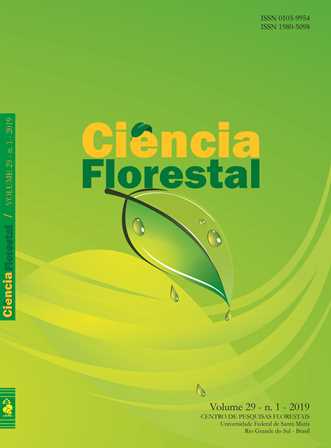Can trinexapac-ethyl stimulate the initial growth of eucalyptus?
DOI:
https://doi.org/10.5902/1980509815326Keywords:
Eucalyptus urograndis, Hormesis, Dose-response, Sub-lethal dosesAbstract
Plant growth regulators and herbicides can act and modify several metabolic processes in plants. The use of sub-lethal doses of those compounds might modulate the development and growth of plants, an effect known as hormesis. Recent studies reported the stimulatory responses of sub-lethal doses of trinexapac-ethyl on the biomass accumulation and leaf area expansion of eucalypt plants. To date, there is no recommendation regarding promoting or inhibitory doses of such compounds for eucalypt production industry. Thus, this work aims to investigate the effect of trinexapac-ethyl on the establishment and initial growth of Eucalyptus urograndis seedlings. Trinexapacethyl was applied at doses varying 15 to 90 g (plus a control treatment) per hectare of active ingredient (g a.i. ha-1) in two application methods: spraying and root immersion. The doses of 15 g a.i. ha-1 through spraying and the 30 g a.i. ha-1 in root immersion resulted in a positive effect on the growth of Eucalyptus urograndis Clone GG100. Total dry biomass increased by 74.6% and 12.8%, respectively, compared to control plants. The spraying of 15 to 90 g a.i. ha-1 of trinexapax-ethyl resulted in a stimulatory effect on the growth of eucalyptus. The doses of 15 and 30 g a.i. ha-1 via root immersion provided a positive effect on the all evaluated characteristics of eucalyptus. The dose of 90 g a.i. ha-1 resulted in an inhibitory effect on eucalyptus growth through root immersion at 35 days after the trinexapac-ethyl applicationDownloads
References
ADAMS, R. et al. Studies on the action of the new growth retardant CGA 163935 (cimectacarb). In: KARSEN, C. M.; van LOON, L. C.;
VREUGDENHIL, D. (Eds). Progress in plant growth regulation. Dordrecht: Kluwer Academic, 1992. p. 818-827.
BACHA, A. L. et al. Trinexapac-ethyl causes stimulatory effect on the initial growth of Eucalyptus urograndis clones. Journal of Agricultural Science, v. 9, n. 10, p. 189-197, 2017.
BELZ, R.G.; Duke S.O. Herbicides and plant hormesis. Pest Management Science, v.70 p. 698 – 707, 2014.
CALABRESE, E. J.; BALDWIN, L. A. Hormesis: a generalizable and unifying hypothesis. Critical Reviews in Toxicology, v. 31, p. 353-424, 2001.
CALABRESE, E. J.; BALDWIN, L. A. Defininghormesis. Human Experimental Toxicology, v. 21, p. 91-97, 2002.
CARVALHO, L.B., ALVES, P.L.C.A.; DUKE, S.O. Hormesis with glyphosate depends on coffee growth stage. Proceedings of the Brazilian Academy of Science, v 85, p 813 – 821, 2013.
CEDERGREEN, N.; OLESEN, C.F. Can glyphosate stimulate photosynthesis? Pesticide Biochemistry Physiology, v. 96, p. 140 – 148, 2010.
ERVIN, E. H.; KOSKI, A. J. Trinexapac-ethyl increases Kentucky bluegrass leaf cell density and chlorophyll concentration. Hortscience, v. 36, n. 4, p. 787-789, 2001.
FLETCHER, R. A. et al. Triazoles as plant growth regulators and stress protectants. Horticultural reviews, v. 24, n. 1, p. 55-138, 2000.
HISAMATSU, T. et al. Effect of gibberellin A4 and GA biosynthesis inhibitors on growth and flowering of stock [Matthiola incana (L.) R. Br.]. Journal of the Japanese Society for Horticultural Science, v. 64, n. 4, p. 537-543, 1998.
KOROL, L.; KLEIN, J. D. Profiles of trinexpac-ethil - and ABA – induced heat-stable proteins in embrionic axes of wheat seeds. Euphytica, v. 126, p. 77-81. 2002.
KOZLOWSKI, T. T.; KRAMER, P. J.; PALLARDY, S. G. The physiological ecology of woody plants. Academic Press, San Diego, p. 303-337, 1991.
LETHAM, D. S.; PALNI, L. M. S. The biosynthesis and metabolism of cytokinins. Annual Review of Plant Physiology, Palo Alto, v. 34, p. 163-197, 1983
LIU, A.; LATIMER, J. G. Water relations and abscisic acid levels of watermelon as affected by rooting volume restriction. Journal of Experimental Botany, Oxford, v. 46, n. 289, p. 1011-1015, 1995.
PEREIRA, F.C.M. et al. Response of eucalyptus (Eucalyptus urograndis) plants at different doses of glyphosate. Journal of Agricultural Science, v. 5, p. 66 – 74, 2013.
PIRES, R.N. et al. Effects of the simulated drift of ripeners on Eucalyptus urograndis. Journal of Agricultural Science, v. 5, n. 12, p. 78-86, 2013.
RADEMACHER, W. Growth retardants: effects on giberellin biosynthesis and other metabolic pathways. Annual Review Plant Physiology Plant Molecular Biology v. 51, p. 501-531, 2000.
RADEMACHER, W. Chemical regulators of gibberellin status and their application in plant production. Annual Plant Reviews, v. 49, p. 359-403, 2016.
RAJALA, A. et al. Effects of applying stem-growth regulators to leaves on root elongation by seedlings of wheat, oat and barley: mediation by ethilene. Plant Growth Regulation v. 38, p. 51-59, 2002
ROBBINS, N. S.; PHARR, D. M. Effect of restricted root growth on carbohydrate metabolism and whole plant growth of Cucumissativus L. Plant Physiology, Minneapolis, v. 87, p. 409-413, 1988.
STEBBING, A. R. D. A theory of growth hormesis. Mutation Research, v. 403, p. 249-258, 1998.
SOUTHAM, C. M.; ERLICH, J. Effects of extract of western red-cedar heartwood on certain wood-decaying fungi in culture. Phytopathology, v. 33, p. 517-524, 1943.
TAIZ, L.; ZEIGER, E. Fisiologia vegetal. 5. ed. Porto Alegre: Artmed, 2013.
VAN IERSEL, M. Root restriction effects on growth and development of salvia (Salvia splendens). HortScience, Alexandria, v 32, n. 7, p. 1186-1190, 1997.
VELINI, E.D. et al. Glyphosate at low doses can stimulate plant growth. Pest Management Science, v. 64, p 489 – 496, 2008.







